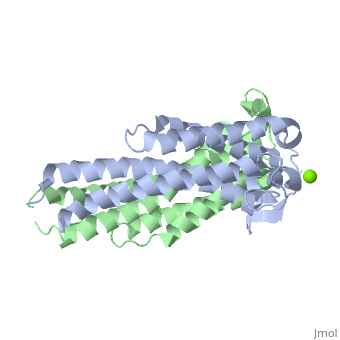G18secL03Tpc4
From Proteopedia
| Line 3: | Line 3: | ||
One of the major antigens on the surface of the Lyme disease spirochete, Borrelia burgdorferi, is the outer surface protein C (OspC) (Kumaran 2001). It greatly differs from other outer surface proteins, such as OspA and OspB in both structure and function. The uniqueness of OspC is that it comes into play when the pathogen is being transmitted to humans or other mammals. OspC is being produced by Borrelia burgdorferi when infected ticks feed, but its synthesis known to slow down greatly after transmission to a mammalian host. It was demonstrated that those spirochetes that lack OspC are capable to replicate inside and migrate to the salivary glands of the tick vector but do not infect mammals (Kumaran 2001). Therefore, OspC is believed to determine virulence of the spirochete to mammals, including humans. | One of the major antigens on the surface of the Lyme disease spirochete, Borrelia burgdorferi, is the outer surface protein C (OspC) (Kumaran 2001). It greatly differs from other outer surface proteins, such as OspA and OspB in both structure and function. The uniqueness of OspC is that it comes into play when the pathogen is being transmitted to humans or other mammals. OspC is being produced by Borrelia burgdorferi when infected ticks feed, but its synthesis known to slow down greatly after transmission to a mammalian host. It was demonstrated that those spirochetes that lack OspC are capable to replicate inside and migrate to the salivary glands of the tick vector but do not infect mammals (Kumaran 2001). Therefore, OspC is believed to determine virulence of the spirochete to mammals, including humans. | ||
=== Basic Structure === | === Basic Structure === | ||
| - | ==== Putative Binding Site ==== | ||
=== Main Function === | === Main Function === | ||
| + | === Putative Binding Site === | ||
=== Role of OspC in Lyme Disease === | === Role of OspC in Lyme Disease === | ||
=== OspC-based Vaccine Against Lyme Disease === | === OspC-based Vaccine Against Lyme Disease === | ||
==== Main Advantages of Developing OspC-based Vaccine ==== | ==== Main Advantages of Developing OspC-based Vaccine ==== | ||
==== Main Problems with Application of OspC-based Vaccine ==== | ==== Main Problems with Application of OspC-based Vaccine ==== | ||
Revision as of 15:01, 14 August 2012
|
Outer surface protein C (OspC)of Borrelia burgdorferi One of the major antigens on the surface of the Lyme disease spirochete, Borrelia burgdorferi, is the outer surface protein C (OspC) (Kumaran 2001). It greatly differs from other outer surface proteins, such as OspA and OspB in both structure and function. The uniqueness of OspC is that it comes into play when the pathogen is being transmitted to humans or other mammals. OspC is being produced by Borrelia burgdorferi when infected ticks feed, but its synthesis known to slow down greatly after transmission to a mammalian host. It was demonstrated that those spirochetes that lack OspC are capable to replicate inside and migrate to the salivary glands of the tick vector but do not infect mammals (Kumaran 2001). Therefore, OspC is believed to determine virulence of the spirochete to mammals, including humans.
Contents |
Basic Structure
Main Function
Putative Binding Site
Role of OspC in Lyme Disease
OspC-based Vaccine Against Lyme Disease
Main Advantages of Developing OspC-based Vaccine
Main Problems with Application of OspC-based Vaccine
Proteopedia Page Contributors and Editors (what is this?)
Ekaterina Shnaydman, Paramjit Singh, Olivia Cary, Michal Harel, Alexander Berchansky

